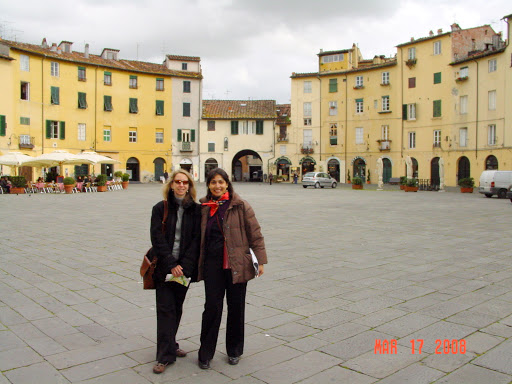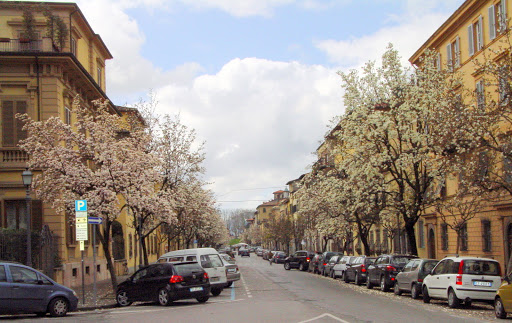Lovely Lucca
(Amy and I pose in Lucca’s famous Amphitheatro)
It was my students (many of whom have spent a semester in Florence, Italy) who told me about Lucca. “You Must go to Lucca” they said. “You’re bound to love it”. Situated only twenty minutes by train from Pisa, it can so easily be covered in the same day. On the train that was crowded with chattering Italian commuter students, we enjoyed the passing Tuscan scenery with its spring growth slowly emerging after a short winter’s slumber. There were the cypress trees rising like sentinels in the midst of wheat fields and farm houses all painted in those striking shades of yellow and orange that make the countryside so distinctive in this part of Italy.
Spring Time in Lovely Lucca:
Stashing our bags in the Tourist Information kiosk for a small fee and equipped with a map, we began our exploration of this little-known township passing through its massive walls for Lucca is a fortified Roman city whose ramparts are thick brick walled walkways designed to keep enemies at bay. Once inside the city, we noticed that spring had come to the cherry trees that lined the narrow streets, so profusely were they in bloom. Utterly delightful (above left)!
The Church of San Martino:
The walls of the famous Duomo of San Martino (St. Martin) whose construction began in 1093 towered above us and we headed at leisure towards its square which was almost deserted but for a small student group. Once at the church door, we used our tourist literature to observe curious elements of its exterior architecture. Also built in Pisan-Romanesque style, this grey and white marble building and its accompanying red-brick campanile or bell-tower contrasted oddly with each other (left). Once inside, we discovered that the church houses three precious items: A crucifix portraying the Holy Face (Volto Santo) of Christ that is supposed to have been carved by St. Nicodemus at the time that he helped take Christ down from the cross, a gilded altarpiece by Ghirlandaio and a marvelous piece of funerary sculpture–the Tomb of Illaria del Carretto, a young bride, by Jacopo della Quercia. She was so deeply loved that when she died in childbirth, she was greatly mourned by her husband who commissioned the sculpture. If Illaria did indeed look exactly as she was sculpted, she must have been a stunner for her face is exquisite. The cold white marble and her reclining posture give the entire work an ethereal air and we felt the need to whisper in the sacristy where the figure is concealed. Be prepared to pay a small fee to see the altarpiece and the sculpture.
Along Via Fialuongo:
Leaving the cathedral square behind us, we walked towards Lucca’s famed amphitheater along Via Fialuongo, whose boutiques were crammed with fashionable clothing, leather goods and jewelry. The weather was just perfect for casual sauntering and the city’s cobbled streets were virtually empty. We were grateful to have made our entry into Italy through these quiet smaller towns in whose medieval quarters cars are prohibited. These made for delightfully aimless rambles and though we were already foot sore by this point in our travels, we were loathe to stop anywhere to rest.
The Roman Amphitheater:
Lucca’s Roman Amphitheatro is truly unique. Built by the Romans as an amphitheater for bloody gladiatorial sport, the structure today contains homes, shops and restaurants built on top of what were once the walls of the collosseum and, therefore, forms a perfect oval. Within the spacious expanses of this shape, we walked in wonder, amazed to think that the arched entrances we saw around us were once the openings for enslaved gladiators and the wild beasts who entertained blood-thirsty crowds. Once again, it was the uniformly warm shades of yellow reaching towards orange and red that made the amphitheater striking.
The Church of San Frediano:
Leaving it behind us, we walked towards the Church of San Frediano (left) whose façade featured an impressive Biblical mosaic that glittered in the bright sunlight. This Pisan-Romanesque church was closed but the quiet square within which it is set was very charming indeed. It is easy to get lost in the streets of Lucca as the eye is attracted to all sorts of charming corners.
The Church of San Michele in Foro:
Following our map, we made our way towards the Church of San Michele in Foro (the church of St. Michael in the Forum–left), so-called because it is built on the site of what was formerly the Roman Forum. Another wonderful structure in Pisan-Romanesque design, it is set in a busy square in which brisk trading was carried out by a variety of vendors. We realized that the squares of most tourist sites, churches especially, have been converted into sites for petty trade, a matter of which Christ might not have approved (remember how he chased away the traders from the temple at Jerusalem?) and of which I did not approve either as I felt that the sanctity and the beauty of these public spaces were completely destroyed by unsightly white awnings. This particular church is crowned by a gilded sculpture of Archangel Michael after whom it is named.
Home of Composer Puccini:
A few lanes away in a quiet, unassuming piazza is a sculpture of Giacomo Puccini, Italy’s beloved composer of such famous operas as Tosca, Turandot, La Boheme and Madame Butterfly. I was so pleased to come upon the very square that contains the modest home in which this composer was born and composed some of my favorite arias such as “O Mio Bambino Caro” (from Gianni Schicchi) and “Nessun Dorma” (from Turandot). Puccini sits majestically on a grand chair lording it over the square, his cigar hanging from his hand in complete defiance of every contemporary health rule (above left). His home, now a museum to the composer’s memory, was closed which did not allow us to see the very desk at which he composed some of his best-known works.
Piazza Napoleon:
Returning to Lucca’s railway station via Piazza Napoleon which contains a sculpture of the Emperor’s sister Louisa (left), we walked along the ramparts, stopping to take pictures of the Roman lion of Lucca and to enjoy our first gelatos in Italy as we selected from a wide variety of ice-cream in a very cute gelateria.
Then, we boarded a train that took us into the beautiful heart of the Tuscan countryside past more wheat fields and orange groves, sheep dotted hillsides and yellow plastered farm dwellings. An hour later, our train pulled into Santa Maria Novella Train Station in Florence that is usually referred to as Statione Centrale.
To follow Amy and me on the next leg of our travels in Florence, Italy, please click on this link below:
Bon Voyage!

